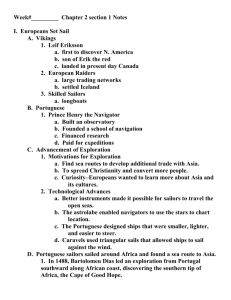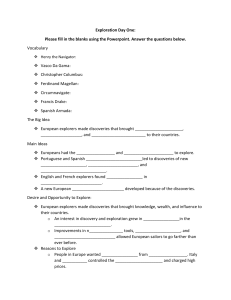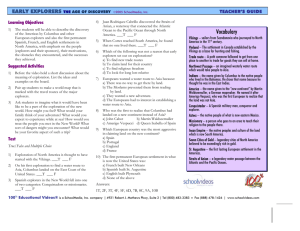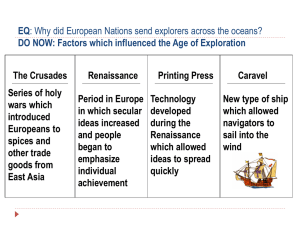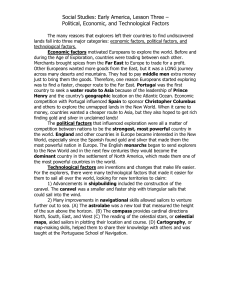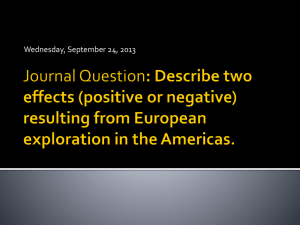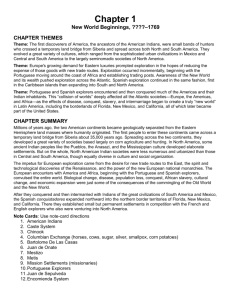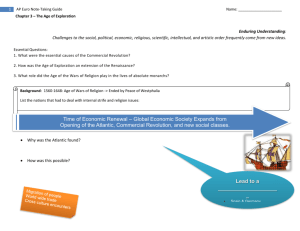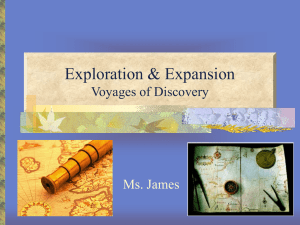Spanish & Portugese Explorations Notes
advertisement
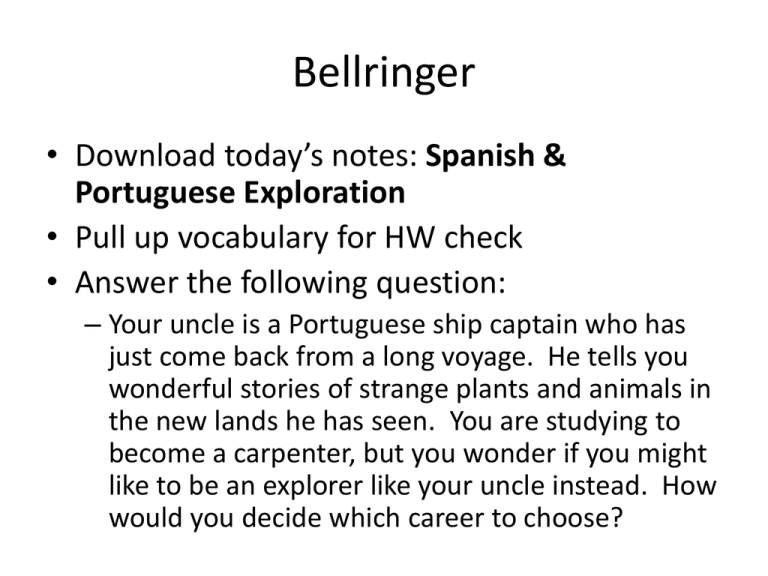
Bellringer • Download today’s notes: Spanish & Portuguese Exploration • Pull up vocabulary for HW check • Answer the following question: – Your uncle is a Portuguese ship captain who has just come back from a long voyage. He tells you wonderful stories of strange plants and animals in the new lands he has seen. You are studying to become a carpenter, but you wonder if you might like to be an explorer like your uncle instead. How would you decide which career to choose? Great Voyages of Discovery The Big Idea European explorers brought knowledge, wealth, and influence to their countries. Main Ideas • Europeans had a desire and opportunity to explore in the 1400s and 1500s. • Portuguese and Spanish explorers discovered new trade routes, lands, and people. • The English and French claimed land in North America. Main Idea 1: Europeans had a desire and opportunity to explore in the 1400s and 1500s. An interest in discovery and exploration grew in Europe in the 1400s. Improvements in navigational tools, cartography, and shipbuilding allowed European sailors to go farther than ever before. Reasons to Explore • People in Europe wanted goods from Asia. Italy and Egypt controlled the trade routes and charged high prices. Europeans wanted to find their own trade routes so they wouldn’t have to pay the fees. • Christians wanted to spread their ideas about religion to other parts of the world. • Advances in technology made exploration possible. Advances in Technology • Sailors now had instruments such as the astrolabe and the compass to find new routes. • More-accurate maps allowed sailors to travel from one port to the next by using the open sea and by not having to follow the coast. • Shipbuilders, especially the Portuguese, made new ships called caravels with better sails and better steering. Connect! • 1. What reasons prompted Europeans to explore in the 1400s? • 2. What advances in technology aided exploration? Main Idea 2: Portuguese and Spanish explorers discovered new trade routes, lands, and people. Prince Henry the Navigator was responsible for most of Portugal’s success on the seas. He built an observatory and a navigation school and paid people to sail on explorations. Exploration • In 1498 Vasco da Gama sailed around Africa and landed on the west coast of India. – This established the sea route to Asia. • One Italian sailor, Christopher Columbus, believed that he could reach Asia by sailing west across the Atlantic. – The King Ferdinand and Queen Isabella of Spain gave Columbus the money to make his journey. – In October 1492, Columbus landed on a small island in the Bahamas. He believed that he had reached Asia. • Ferdinand Magellan was the first explorer to sail around the tip of South America and circumnavigate, or go all the way around, the globe. A “New World” • Spanish explorers called the Americas the New World. • When Spanish explorers arrived, the Aztec and Inca empires were at the height of their powers. • Spanish explorers (conquistadors) in the New World found gold and silver as they conquered the empires there. Also wanted to convert natives to Christianity. • They also passed along diseases to the native peoples that killed possibly more than threequarters of them. Line of Demarcation Connect! • 1. What was Henry the Navigator’s contribution to the world of exploration? • 2. Who was the first European to sail around Africa and land in India? • 3. What explorer led the first voyage around the globe? • 4. Why do you think Europeans explorers called the Americas the “New World”? • 5. What was the purpose of the Line of Demarcation? Homework • Download the primary source posted on the website for today: Christopher Columbus • Read the source, then answer the questions on a piece of paper to turn in tomorrow. • We will discuss this source in class tomorrow.



